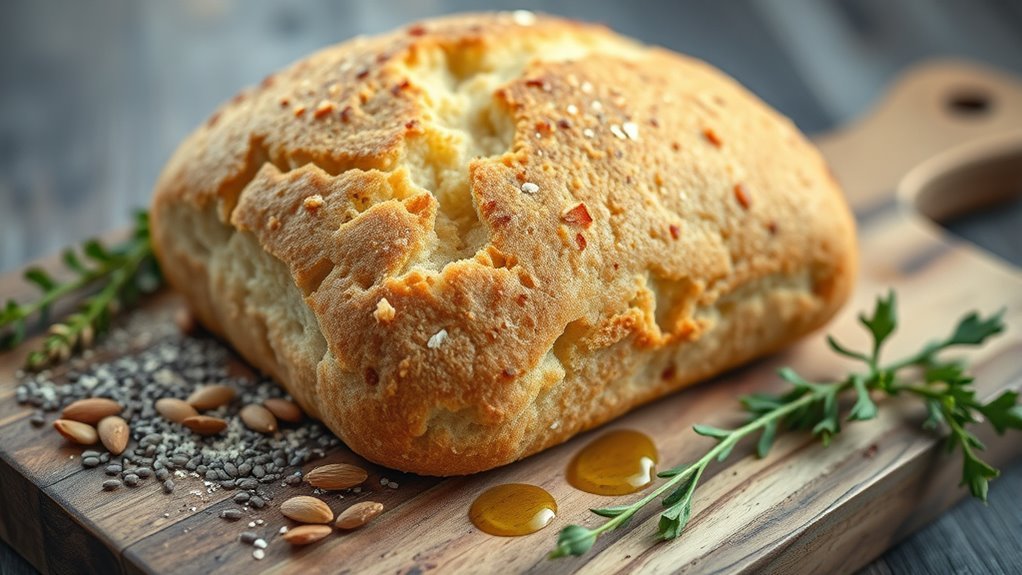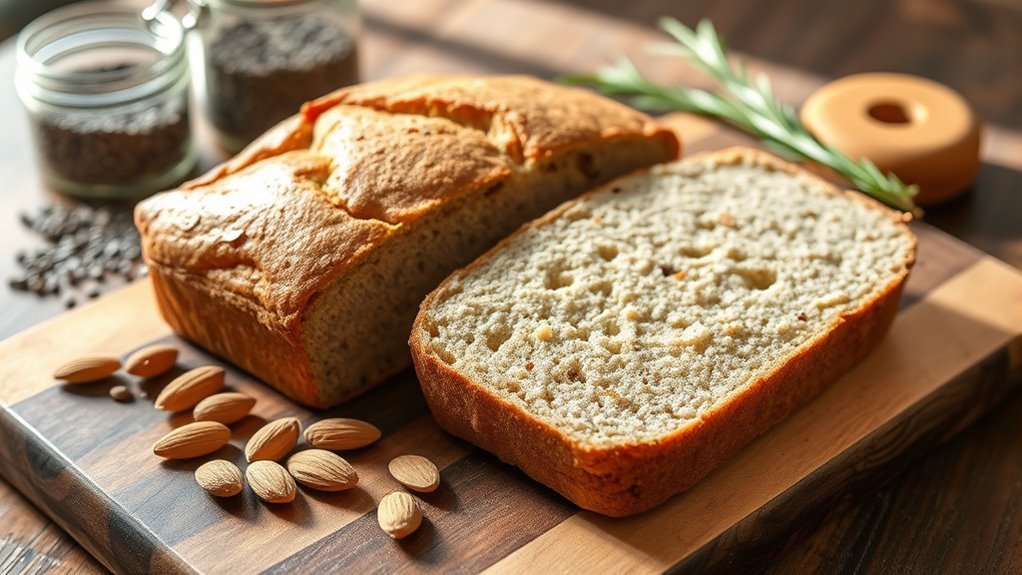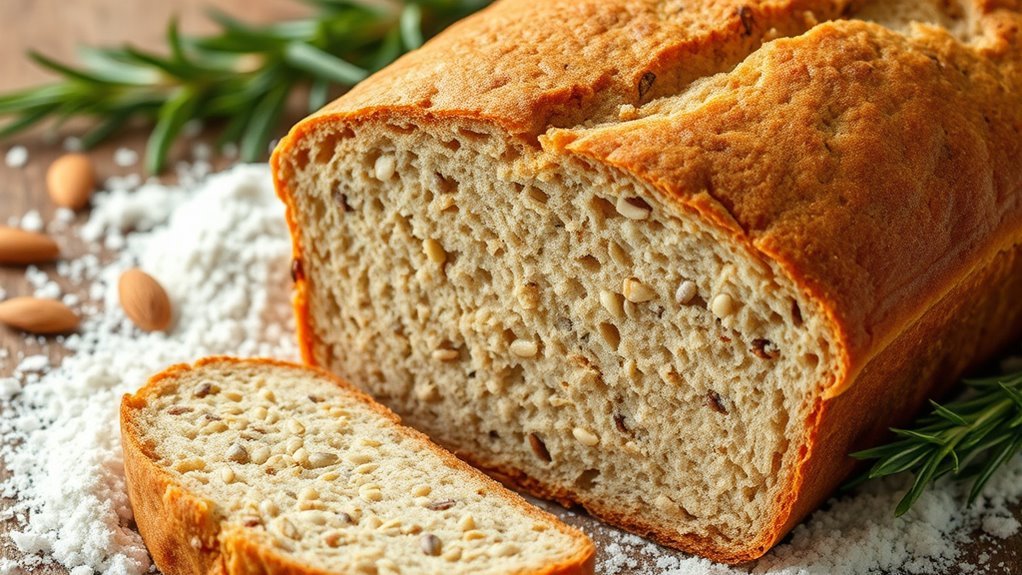Keto bread is primarily made from low-carb ingredients like almond flour and coconut flour, which provide a nutritious base. Eggs are essential for binding and moisture, while low-carb sweeteners like stevia or erythritol can add a touch of sweetness without increasing carbs. You can also include various flavorings and add-ins, such as seeds, herbs, or spices, to enhance taste and texture. There’s a lot more to explore about customizations and variations, so stick around!
The Basics of Keto Bread

When you’re starting on a ketogenic diet, understanding the basics of keto bread can be essential to maintaining your low-carb lifestyle. Unlike traditional bread, keto bread options typically use low-carb ingredients, allowing you to enjoy your favorite sandwiches without derailing your diet. Commonly used ingredients include almond flour, coconut flour, and eggs, which provide the necessary structure and flavor.
You can explore various keto bread recipes that cater to your taste, from simple flatbreads to hearty loaves. These recipes often incorporate seeds and spices for added texture and nutrition. By familiarizing yourself with these options, you’ll find it easier to create satisfying meals while staying true to your ketogenic goals. Embrace the freedom to enjoy bread again!
Almond Flour: The Star Ingredient

Almond flour is a powerhouse ingredient in keto baking, packed with healthy fats, fiber, and protein. Its versatility allows you to create a wide range of recipes, from bread to pancakes, without sacrificing taste or texture. By incorporating almond flour into your diet, you not only enhance your meals but also boost your nutritional intake.
Nutritional Benefits of Almond Flour
Nutritious and versatile, almond flour stands out as a cornerstone ingredient in keto bread recipes. When you choose almond flour, you’re not just opting for a gluten-free alternative; you’re also reaping substantial almond nutrition and health benefits.
- High in healthy fats, promoting heart health
- Rich in protein, aiding muscle maintenance
- Packed with fiber, supporting digestive health
- Loaded with vitamins and minerals, boosting overall wellness
Incorporating almond flour into your diet can help you feel satisfied while keeping your carb intake low. Plus, it’s a fantastic way to enjoy bread without compromising your health goals. With almond flour, you’re embracing freedom in your diet while nourishing your body with essential nutrients.
Almond Flour Versatility in Recipes
With its impressive nutritional profile, almond flour is not just a health-conscious choice but also a remarkably adaptable ingredient in a variety of recipes. You can experiment with almond flour in everything from pancakes to pizza crusts, making it a staple in your keto kitchen. When you’re exploring recipe variations, consider blending it with other low-carb flours to achieve different textures. For best results, remember these baking tips: almond flour absorbs moisture differently than wheat flour, so you might need to adjust liquid ingredients accordingly. Additionally, letting your batter rest can improve texture. Embracing almond flour opens the door to delicious, healthy options, allowing you to enjoy your favorite dishes without compromising your dietary goals.
Coconut Flour: A Nutty Alternative

While you might think of traditional flour as a staple in baking, coconut flour emerges as a versatile and nutty alternative that’s particularly popular in keto recipes. It offers several coconut flour benefits, making it a fantastic choice for those looking to reduce carbs while still enjoying baked goods.
Consider these appealing aspects of coconut flour:
- High in fiber, promoting digestive health
- Naturally gluten-free, perfect for sensitive diets
- Low in carbs, aligning with keto goals
- Adds a unique, rich flavor to your recipes
With various coconut flour recipes available, you can easily incorporate this ingredient into your favorite treats, giving you the freedom to indulge without guilt. Embrace this nutty alternative and enjoy delicious, guilt-free baking!
Seed Flours: Adding Crunch and Nutrition
Seed flours are gaining popularity in the keto baking scene, offering both texture and nutrition. Chia seeds and flaxseed meal are excellent sources of fiber and omega-3 fatty acids, making your bread more filling. Pumpkin seeds and sunflower seeds add a delightful crunch while providing essential minerals like magnesium and zinc. You can also incorporate sesame seeds for a nutty flavor and added calcium. Nutritional yeast can enhance your bread’s taste profile, giving it a cheesy essence without the carbs. By experimenting with these seed flours, you’ll not only improve the nutritional value of your keto bread but also satisfy your cravings for texture and flavor. Embrace these ingredients to create delicious, healthy options for your low-carb lifestyle.
Eggs: The Binding Agent
Eggs play an essential role in keto bread recipes as a binding agent, enhancing texture and moisture. They’re packed with nutritional benefits, providing protein and essential vitamins, which make them a valuable addition to your low-carb diet. When selecting egg varieties, understanding their impact on binding compared to traditional flours can help you achieve the perfect loaf.
Nutritional Benefits of Eggs
Although many may overlook their nutritional profile, eggs serve as a powerhouse of essential nutrients, making them a significant ingredient in keto bread. Packed with high-quality protein, eggs are an excellent protein source that can help you feel full longer, supporting your weight loss goals. Beyond protein, their egg nutrition includes important vitamins and minerals that contribute to overall health.
- Rich in omega-3 fatty acids, promoting heart health
- Loaded with B vitamins for energy metabolism
- Contain choline, essential for brain function
- Offer antioxidants that support eye health
Incorporating eggs into your keto bread not only enhances texture but also boosts nutritional value, giving you the freedom to enjoy delicious, healthful meals.
Egg Varieties to Use
When it comes to selecting the right eggs for your keto bread, not all varieties are created equal. Fresh, organic eggs are often recommended due to their superior flavor and nutritional profile. Their yolks can add richness and moisture, essential for a satisfying texture. If you’re exploring egg substitutes, options like flaxseed meal or chia seeds can work, but they may alter the final product’s consistency. Consider the egg types you choose; for instance, cage-free eggs often have higher omega-3 content, which can enhance your bread’s health benefits. Ultimately, the right eggs or substitutes can make a significant difference in achieving that perfect keto bread, offering you both freedom and flavor while keeping your dietary goals in mind.
Binding vs. Traditional Flours
While many traditional bread recipes rely on wheat flour as the main ingredient, keto bread often turns to alternative binding agents to achieve the right texture. Eggs are a popular choice, acting as a powerful binding agent that helps hold the ingredients together without the need for traditional flours.
Consider these benefits of using binding agents in keto bread:
- They provide moisture and richness.
- They enhance the structure and stability.
- They contribute to a more satisfying bite.
- They allow you to enjoy bread without the carbs.
Low-Carb Sweeteners: For a Touch of Sweetness
Have you ever wondered how to satisfy your sweet tooth without derailing your low-carb diet? Fortunately, low-carb sweeteners can help. These sweet alternatives to sugar allow you to enjoy treats while staying on track. Natural sweeteners like stevia and erythritol are popular choices, and low carb syrups like monk fruit syrup can add flavor to your keto bread.
Here’s a quick comparison to help you choose:
| Sweetener | Type | Net Carbs (per serving) |
|---|---|---|
| Stevia | Natural | 0 |
| Erythritol | Sugar Alcohol | 0 |
| Monk Fruit Syrup | Natural | 0 |
With these options, you can indulge in sweetness without guilt!
Additional Flavorings and Add-Ins
How can you take your keto bread to the next level? By incorporating additional flavorings and add-ins, you can create a loaf that’s not just nutritious but also bursting with taste. Here are some fantastic options to contemplate:
- Herb blends for a fresh, aromatic twist
- Cheese options to add creaminess and depth
- Nut butters for a rich, satisfying texture
- Seed toppings to enhance crunch and nutrition
Don’t forget about vegetable additions for moisture and flavor, spice variations for a kick, and protein boosts to keep you energized. Fermented flavors can also introduce unique tanginess. Embrace these elements to craft a keto bread that truly reflects your culinary freedom!


